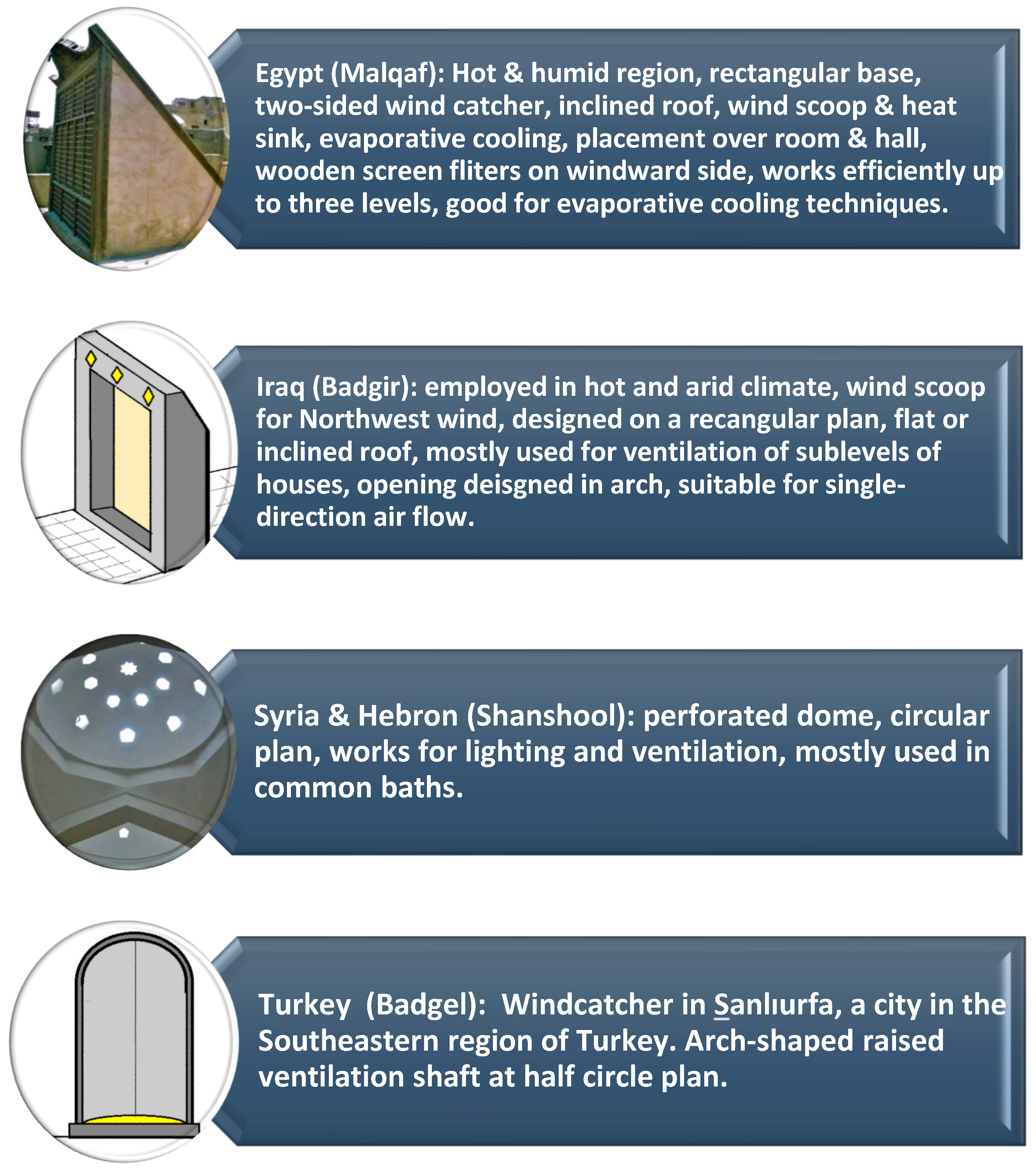Wind Catchers: An Element of Passive Ventilation in Hot, Arid and Humid Regions, a Comparative Analysis of Their Design and Function
Abstract
:1. Introduction
2. Wind Catchers as Sustainable and Energy-Saving Elements
3. Classification and Design of Classical Wind Catchers
4. Geographical and Regional Influences on Wind Catcher Design
4.1. Wind Catchers of Egypt
4.2. Wind Catchers of Iraq
4.3. Wind Catchers of Syria
4.4. Wind Catchers of Turkey
4.5. Indus Wind Catchers in Pakistan
4.6. Wind Catchers of India
4.7. Wind Catchers in Afghanistan
4.8. Wind Catchers in Countries of the Gulf Cooperation Council (GCC)
4.9. Wind Catchers of Iran
5. Performance Evaluation of Wind Catchers
6. Wind Catchers from Functional to Symbolic Elements
7. Design Features of Contemporary Wind Catchers
8. Conclusions
Author Contributions
Funding
Institutional Review Board Statement
Informed Consent Statement
Data Availability Statement
Acknowledgments
Conflicts of Interest
References
- Stouhi, D. What Is a Traditional Windcatcher. 3 November 2021. Available online: https://www.archdaily.com/971216/what-is-a-traditional-windcatcher (accessed on 28 July 2022).
- Bidisha, S. Hawa Mahal Jaipur India. Britannica. Available online: https://www.britannica.com/place/Hawa-Mahal (accessed on 28 July 2022).
- Hedayat, Z.; Belmans, B.; Ayatollahi, M.H.; Wouters, I.; Descamps, F. Performance Assessment of Ancient Wind Catchers—An Experimental and Analytical Study. Energy Procedia 2015, 78, 2578–2583. [Google Scholar] [CrossRef]
- Dehghan, A.A.; Dehghan Manshadi, M.; Kazemi Esfeh, M. Wind-catchers, creative buildings’ elements for passive ventilation. Adv. Energy Res. Dev. 2014, 6, 189–222. [Google Scholar]
- Oropeza-Perez, I.; Østergaard, P.A. Active and passive cooling methods for dwellings: A review. Renew. Sustain. Energy Rev. 2018, 82, 531–544. [Google Scholar] [CrossRef]
- Ahmed, T.; Kumar, P.; Mottet, L. Natural ventilation in warm climates: The challenges of thermal comfort, heatwave resilience and indoor air quality. Renew. Sustain. Energy Rev. 2021, 138, 110669. [Google Scholar] [CrossRef]
- Wang, Y.; Kuckelkorn, J.; Zhao, F.-Y.; Spliethoff, H.; Lang, W. A state of art of review on interactions between energy performance and indoor environment quality in Passive House buildings. Renew. Sustain. Energy Rev. 2017, 72, 1303–1319. [Google Scholar] [CrossRef]
- Miranda, N.D.; Renaldi, R.; Khosla, R.; McCulloch, M.D. Bibliometric analysis and landscape of actors in passive cooling research. Renew. Sustain. Energy Rev. 2021, 149, 111406. [Google Scholar] [CrossRef]
- Moosavi, L.; Mahyuddin, N.; Abdul Ghafar, N.; Ismail, M.A. Thermal performance of atria: An overview of natural ventilation effective designs. Renew. Sustain. Energy Rev. 2014, 34, 654–670. [Google Scholar] [CrossRef]
- O’Connor, D.; Calautit, J.K.; Hughes, B.R. A novel design of a desiccant rotary wheel for passive ventilation applications. Appl. Energy 2016, 179, 99–109. [Google Scholar] [CrossRef]
- Dehghan, A.A.; Esfeh, M.K.; Manshadi, M.D. Natural ventilation characteristics of one-sided wind catchers: Experimental and analytical evaluation. Energy Build. 2013, 61, 366–377. [Google Scholar] [CrossRef]
- Sadeghi, H.; Kalantar, V. Performance analysis of a wind tower in combination with an underground channel. Sustain. Cities Soc. 2018, 37, 427–437. [Google Scholar] [CrossRef]
- Bahadori, M.N. Viability of wind towers in achieving summer comfort in the hot arid regions of the middle east. Renew. Energy 1994, 5, 879–892. [Google Scholar] [CrossRef]
- Khalili, M.; Amindeldar, S. Traditional solutions in low energy buildings of hot-arid regions of Iran. Sustain. Cities Soc. 2014, 13, 171–181. [Google Scholar] [CrossRef]
- Ramzy, N. Sustainable spaces with psychological connotation: Historical architecture as reference book for biomimetic models with biophilic qualities. Archnet IJAR 2015, 9, 248–267. [Google Scholar] [CrossRef]
- Chakraborty, J.; Fonseca, E. Analysis and Evaluation of a Passive Evaporative Cool Tower in conjunction with a Solar Chimney. In Proceedings of the PLEA2005—The 22nd Conference on Passive and Low Energy Architecture, Beirut, Lebanon, 13–16 November 2005. [Google Scholar]
- Jomehzadeh, F.; Nejat, P.; Calautit, J.K.; Yusof, M.B.M.; Zaki, S.A.; Hughes, B.R.; Yazid, M.N.A.W.M. A review on windcatcher for passive cooling and natural ventilation in buildings, Part 1: Indoor air quality and thermal comfort assessment. Renew. Sustain. Energy Rev. 2016, 70, 736–756. [Google Scholar] [CrossRef]
- Drach, P.R.C. A study on air circulation: The case of house vi of “vila” 37 with the application of wind-catch. Build. Simul. 2009, 2, 5. [Google Scholar] [CrossRef]
- Elmualim, A.A. Verification of Design Calculations of a Wind Catcher/Tower Natural Ventilation System with Performance Testing in a Real Building. Int. J. Vent. 2006, 4, 393–404. [Google Scholar] [CrossRef]
- Roaf, S. The Traditional Technology Trap (2): More lessons from the wind catchers of Yazd. In Proceedings of the PLEA 2008—25th Conference on Passive and Low Energy Architecture, Dublin, Ireland, 22–24 October 2008. [Google Scholar]
- Yousuf, W. The challenge of sustainability in developing countries and the adaptation of heritage-inspired architecture in context. Archnet-IJAR 2011, 5, 7. [Google Scholar]
- Janajreh, I.; Adouane, K.; Hussain, M. Wind catcher and trans-evaporative cooling residential integration in arid region. Int. J. Therm. Environ. Eng. 2017, 14, 1–9. [Google Scholar]
- Khalaf, R.W. Traditional vs. modern Arabian morphologies. J. Cult. Herit. Manag. Sustain. Dev. 2012, 2, 27–43. [Google Scholar] [CrossRef]
- Almusaed, A. Biophilic and Bioclimatic Architecture; Springler: London, UK, 2011. [Google Scholar] [CrossRef]
- Dabiri Moradi, S. The review of Persian garden concept in terms of achieving sustainable city: Case study of Dolatabad garden in Yazd city, Iran. Manag. Res. Pract. 2014, 6, 57–71. [Google Scholar]
- Mahmoud, A. A review on wind catcher for passive cooling and natural ventilation in buildings, Part 1: Indoor air quality and thermal comfort assessment. Int. J. Archit. Urban Dev. 2019, 9, 5–16. [Google Scholar]
- Samadzadehyazdi, S.; Khalili, M.J.; Mahdavinejad, S. Windphil poetic in architecture: Energy efficient strategies in modern buildings of Iran. Int. J. Civ. Environ. Eng. 2018, 12, 651–658. [Google Scholar]
- Nejat, P.; Jomehzadeh, F. Windcatcher as a Persian sustainable solution for passive cooling. Civ. Eng. Res. J. 2018, 6, 555679. [Google Scholar] [CrossRef]
- Mazidi, M.; Dehghani, A.R.; Aghanajafi, C. Wind towers’ role in natural air conditioning and passive cooling of buildings in hot, arid regions. WSEAS Trans. Fluid Mech. 2006, 1, 959–966. [Google Scholar]
- Zad, V. Geometric reconstruction of Amir-Chakhmagh square through back ward perspective. Kybernetes 2011, 40, 1166–1178. [Google Scholar]
- Elborombaly, H.; Prieto, L.F. Adaptation of vernacular designs for contemporary sustainable architecture in middle east and neotropical region. Asian J. Comput. Sci. Inf. Technol. 2015, 6, 13–26. [Google Scholar]
- Alqatrani, F. The old city of al Zubair. The emergence and physical reality (1571–1882 Iraq). Bull. Geogr. Socioecon. Ser. 2015, 27, 17–32. [Google Scholar]
- Mohamed, M.; Nayer, A. On wind catcher integration in contemporary buildings in Jeddah. EQA 2018, 32, 1–14. [Google Scholar]
- Popkin, B.M. Urbanization, Lifestyle Changes and the Nutrition Transition. World Dev. 1999, 27, 1905–1916. [Google Scholar] [CrossRef]
- Binaee, Y.; Raof, B. Developing vernacular passive cooling strategies in (Kurdistan-Iraq). Int. J. Sci. Technol. Res. 2018, 7, 13–20. [Google Scholar]
- Short, C.A.; Song, J.; Mottet, L.; Chen, S.; Wu, J.; Ge, J. Challenges in the low-carbon adaptation of China’s apartment towers. Build. Res. Inf. 2018, 46, 899–930. [Google Scholar] [CrossRef] [Green Version]
- Nasri, M.F.; Hekmatpanah, R. Productivity and Energy Management in Desert Urban. 2010. Available online: https://www.researchgate.net/publication/292885471_Productivity_and_energy_management_in_desert_urban (accessed on 1 January 2021).
- Pérez-Lombard, L.; Ortiz, J.; Pout, C. A review on buildings energy consumption information. Energy Build. 2008, 40, 394–398. [Google Scholar] [CrossRef]
- Santamouris, M. Advances in Passive Cooling; Earthscan: London, UK, 2007. [Google Scholar]
- Saadatian, O.; Haw, L.C.; Sopian, K.; Sulaiman, M.Y. Review of wind catcher technologies. Renew. Sustain. Energy Rev. 2012, 16, 1477–1495. [Google Scholar] [CrossRef]
- Levine, M.; Ürge-Vorsatz, D.; Blok, K.; Geng, L.; Harvey, D.; Lang, S. Residential and commercial buildings. In Climate Change 2007: Mitigation, 1st ed.; Metz, B., Davidson, O.R., Bosch, P.R., Dave, R., Meyer, L.A., Eds.; Contribution of Working Group III to the Fourth Assessment Report of the Intergovernmental Panel on Climate Change; Cambridge University Press: Cambridge, UK; New York, NY, USA, 2007; pp. 387–446. [Google Scholar]
- Hamdy, M.; Hasan, A.; Siren, K. Applying a multi-objective optimization approach for Design of low-emission cost-effective dwellings. Build. Environ. 2011, 46, 109–123. [Google Scholar] [CrossRef]
- Yu, Y.; You, S.; Zhang, H.; Ye, T.; Wang, Y.; Wei, S. A review on available energy saving strategies for heating, ventilation and air conditioning in underground metro stations. Renew. Sustain. Energy Rev. 2021, 141, 110788. [Google Scholar] [CrossRef]
- Sangdeh, P.K.; Nasrollahi, N. Wind catchers and their applications in contemporary architecture. Energy Built Environ. 2022, 3, 56–72. [Google Scholar] [CrossRef]
- Qatar University Wind Catchers. Available online: https://www.archnet.org/sites/288 (accessed on 26 August 2022).
- Mehdi Maneshi, M.; Rezaei-Bazkiaei, A.; Scott Weber, A.; Dargush, G.F. A Numerical Investigation of Impact of Architectural and Climatic Parameters of wind Catcher system on Induced Ventilation. In Proceedings of the ASME 2012 International Mechanical Engineering Congress & Exposition IMECE2012, Houston, TX, USA, 9–15 November 2012. [Google Scholar]
- Alemu, A.T.; Saman, W.; Belusko, M. A model for integrating passive and low energy airflow components into low rise buildings. Energy Build. 2012, 49, 148–157. [Google Scholar] [CrossRef]
- Jones, B.M.; Kirby, R. Quantifying the performance of a top–down natural ventilation Wind catcher. Build. Environ. 2009, 44, 1925–1934. [Google Scholar] [CrossRef]
- Bouchahm, Y.; Bourbia, F.; Belhamri, A. Performance analysis and improvement of the use of wind tower in hot dry climate. Renew. Energy 2010, 36, 898–906. [Google Scholar] [CrossRef]
- Heidarinejad, G.; Heidarinejad, M.; Delfani, S.; Esmaeelian, J. Feasibility of using various kinds of cooling systems in a multi-climates country. Energy Build. 2008, 40, 1946–1953. [Google Scholar] [CrossRef]
- Calautit, J.K.; Hughes, B.R.; Chaudhry, H.N.; Ghani, S. CFD analysis of a heat transfer device integrated wind tower system for hot and dry climate. Appl. Energy 2013, 112, 576–591. [Google Scholar] [CrossRef] [Green Version]
- Montazeri, H.; Azizian, R. Experimental study on natural ventilation performance of one-sided wind catcher. Build. Environ. 2008, 43, 2193–2202. [Google Scholar] [CrossRef]
- Montazeri, H.; Azizian, R. Experimental study on natural ventilation performance of a two-sided wind catcher. Proc. Inst. Mech. Eng. Part A J. Power Energy 2009, 223, 387–400. [Google Scholar] [CrossRef]
- Khani, S.M.R.; Bahadori, M.; Dehghani-Sanij, A. Experimental investigation of a modular wind tower in hot and dry regions. Energy Sustain. Dev. 2017, 39, 21–28. [Google Scholar] [CrossRef]
- Liu, S.; Mak, C.M. Numerical evaluation of louver configuration and ventilation strategies for the wind catcher system. Build. Environ. 2011, 46, 1600–1616. [Google Scholar] [CrossRef]
- Rezaeian, M.; Montazeri, H.; Loonen, R. Science foresight using life-cycle analysis, text mining and clustering: A case study on natural ventilation. Technol. Forecast. Soc. Change 2017, 118, 270–280. [Google Scholar] [CrossRef]
- Bahadori, M.N.; Dehghani-Sanij, A.R. Wind Towers: Architecture, Climate and Sustainability; Springer International Publishing: Cham, Switzerland, 2014. [Google Scholar]
- Amirkhani, A.; Ehsan, Z.; Saidian, A.; Khademi, M. Wind catchers: Remarkable example of Iranian sustainable architecture. J. Sustain. Dev. 2010, 3, 89–97. [Google Scholar]
- Santamouris, M.; Kolokotsa, D. Passive cooling dissipation techniques for buildings and other structures: The state of the art. Energy Build. 2013, 57, 74–94. [Google Scholar] [CrossRef]
- Cuce, E.; Harjunowibowo, D.; Cuce, P.M. Renewable and sustainable energy saving strategies for greenhouse systems: A comprehensive review. Renew. Sustain. Energy Rev. 2016, 64, 34–59. [Google Scholar] [CrossRef]
- Attia, S.; Herde, A.D. Designing the Malqaf for summer cooling in low-rise housing, An experimental study. In Proceedings of Passive and Low Energy Architecture (PLEA); Les Presses de l’Université Laval: Quebec, QC, Canada, 2009. [Google Scholar]
- Montazeri, H. Experimental and numerical study on natural ventilation performance of various multi-opening wind catchers. Build. Environ. 2011, 46, 370–378. [Google Scholar] [CrossRef]
- Ghadiri, M.; Dehnavi, M. The effect of plan size in wind catcher on its ventilation rate. In Proceedings of the RESEARCHWORLD Press International Conference, Kuala Lumpur, Malaysia, 11 October 2014. [Google Scholar]
- Montazeri, H.; Montazeri, F.; Azizian, R.; Mostafavi, S. Two-sided wind catcher performance evaluation using experimental, numerical and analytical modeling. Renew. Energy 2010, 35, 1424–1435. [Google Scholar] [CrossRef]
- Khodakarami, J.; Abouseba, M. Performance of single and multiple pressure wind catchers in terms of air flow changes. Int. J. Energy Environ. 2014, 5, 521–534. [Google Scholar]
- Afshin, M.; Sohankar, A.; Manshadi, M.D.; Esfeh, M.K. An experimental study on the evaluation of natural ventilation performance of a two-sided wind-catcher for various wind angles. Renew. Energy 2016, 85, 1068–1078. [Google Scholar] [CrossRef]
- Mak, C.M.; Cheng, C.; Niu, J.L. The Application of Computational Fluid Dynamics to the Assessment of Green Features in Buildings: Part 1: Wing Walls. Arch. Sci. Rev. 2005, 48, 121–134. [Google Scholar] [CrossRef]
- Ghadiri, M.H.; Lukman, N.; Ibrahim, N.; Mohamed, M.F. Computational Analysis of Wind-Driven Natural Ventilation in a Two Sided Rectangular Wind Catcher. Int. J. Vent. 2013, 12, 51–62. [Google Scholar] [CrossRef]
- Elmualim, A.A. Dynamic modelling of a wind catcher/tower turret for natural ventilation. Build. Serv. Eng. Res. Technol. 2006, 27, 165–182. [Google Scholar] [CrossRef]
- Jafari, D.; Shateri, A.; Nadooshan, A.A. Experimental and numerical study of natural ventilation in four-sided wind tower traps. Energy Equip. Syst. 2018, 6, 167–179. [Google Scholar] [CrossRef]
- Farouk, M. Comparative study of hexagon and square wind catchers using CFD simulations. J. Build. Eng. 2020, 31, 101366. [Google Scholar] [CrossRef]
- Pakari, A.; Ghani, S. Airflow assessment in a naturally ventilated greenhouse equipped with wind towers: Numerical simulation and wind tunnel experiments. Energy Build. 2019, 199, 1–11. [Google Scholar] [CrossRef]
- Elmualim, A. Effect of damper and heat source on wind catcher natural ventilation performance. Energy Build. 2006, 38, 939–948. [Google Scholar] [CrossRef]
- Nejat, P.; Calautit, J.K.; Majid, M.Z.A.; Hughes, B.R.; Jomehzadeh, F. Anti-short-circuit device: A new solution for short-circuiting in windcatcher and improvement of natural ventilation performance. Build. Environ. 2016, 105, 24–39. [Google Scholar] [CrossRef]
- Dehghani-sanij, A.R.; Soltani, M.; Raahemifar, K. A new design of wind tower for passive ventilation in buildings to reduce energy consumption in windy regions. Renew. Sustain. Energy Rev. 2015, 42, 182–195. [Google Scholar] [CrossRef]
- Multidirectional Wind Tower. Available online: https://www.archnet.org/sites/6227 (accessed on 26 August 2022).
- Hughes, B.R.; Calautit, J.K.; Ghani, S.A. The development of commercial wind towers for natural ventilation: A review. Appl. Energy 2012, 92, 606–627. [Google Scholar] [CrossRef]
- Roaf, S. The Wind Catchers of Yazd. Ph.D Thesis, Department of Architecture, Oxford Polytechnic, Oxford, UK, 1988. [Google Scholar]
- Perforated Domes for Ventilation. Available online: https://www.archnet.org/sites/3476 (accessed on 26 August 2022).
- Warren, J.; Fethi, I. Traditional Houses in Baghdad; The Coach Publishing House Limited: Horsham, UK, 1982. [Google Scholar]
- Khalil, B.M. Perforated Building Envelope Guiding the Early Design Phase. Ph.D. Thesis, Department of Architecture, Universiti Degli Studidi Palermo, Palermo, Italy, 2017. [Google Scholar]
- Bekleyen, A.; Melikoğlu, Y. An investigation on the thermal effects of windcatchers. J. Build. Eng. 2020, 34, 101942. [Google Scholar] [CrossRef]
- Hyder Chohan, A.; Irfan Che-Ani, A.; Tawil, N.M.; Memon, Z.; Hashmani, M. Rural housing design in costal belt and prospects to adopt renewable energy for basic electrification. Int. J. Phys. Sci. 2012, 7, 1967–1975. [Google Scholar] [CrossRef]
- Guan, Y. Ancient Wind Catchers in Hyderabad Pakistan. Available online: https://www.insideflows.org/project/ancient-wind-catchers-in-hyderabad/ (accessed on 31 December 2021).
- Ehrlich, S.; Bourgeois, J.-L. Spectacular Vernacular: A New Appreciation of Traditional Desert Architecture. Afr. Arts 1985, 18, 12. [Google Scholar] [CrossRef]
- Herat Citadel Restoration. Available online: https://www.archnet.org/sites/6834?media_content_id=89937a (accessed on 26 August 2022).
- Sodha, M.S.; Bansal, N.K.; Bansal, P.K.; Kumar, A.; Malik, M.A. Solar Passive Building; Part 2: Science & Design; Pergamon Press Inter Series on Building Engineering: Oxford, UK, 1986. [Google Scholar]
- HaIlet, S. Traditional Architecture in Afghanistan; Garland STPM Press: New York, NY, USA, 1983. [Google Scholar]
- Harris, M. Bastakia-Towards an Urban Policy. Ph.D. Thesis, Oxford Polytechnic, Oxford, UK, 1978. [Google Scholar]
- Masuda, S. Iran: Tappeh Sanghe-em Caxmaq, Archie fur Orint forschong, Vol., 31, Austria, p. 212. (1984). Quoted by Ali Mahyari. The Wind Catcher: A passive cooling device for hot and arid climate. Ph.D. Thesis, Department of Architectural and Design Science, University of Sydney, Camperdown, Sydney, Australia, 1996. [Google Scholar]
- Tavassoli, M. City Planning in the Hot, Dry Climate of Iran, Design for Arid Regions; Golany, G., Ed.; Van Nostrand Reinhol: New York, NY, USA, 1982; pp. 121–140. [Google Scholar]
- Ganj i Ali Khan Complex. Available online: https://www.archnet.org/sites/2761 (accessed on 26 August 2022).
- Ab e Anbar Tall Wind Catchers. Available online: https://www.archnet.org/sites/2891 (accessed on 29 August 2022).
- Burujirdi House Iran. Available online: https://www.archnet.org/sites/4750 (accessed on 26 August 2022).
- Aghazadeh House. Available online: https://www.archnet.org/sites/18868?media_content_id=137865 (accessed on 26 August 2022).
- Zhang, Z.; Chen, X.; Mazumdar, S.; Zhang, T.; Chen, Q. Experimental and numerical investigation of airflow and contaminant transport in an airliner cabin mockup. Build. Environ. 2009, 44, 85–94. [Google Scholar] [CrossRef]
- Chen, Q. Ventilation performance prediction for buildings: A method overview and recent applications. Build. Environ. 2009, 44, 848–858. [Google Scholar] [CrossRef]
- Khani, S.M.; Bahadori, M.N.; Dehghani-Sanij, A.; Nourbakhsh, A. Performance Evaluation of a Modular Design of Wind Tower with Wetted Surfaces. Energies 2017, 10, 845. [Google Scholar] [CrossRef]
- Wahab, I.A.; Aziz, H.A.; Salam, N.N.A. Building Design Effect on Indoor Natural Ventilation of Tropical Houses. Int. J. Sustain. Constr. Eng. Technol. 2019, 10. [Google Scholar] [CrossRef]
- Hunt, D.; Mac Suibhne, N.; Dimache, L.; McHugh, D.; Lohan, J. Advances in multifunctional balanced ventilation technology for dwellings and arising challenge to quantify energy efficiency and renewable generation contributions using international test standards. Renew. Sustain. Energy Rev. 2020, 134, 110327. [Google Scholar] [CrossRef]
- O’Connor, D.; Calautit, J.K.; Hughes, B.R. A review of heat recovery technology for passive ventilation applications. Renew. Sustain. Energy Rev. 2016, 54, 1481–1493. [Google Scholar] [CrossRef]
- Tejero-González, A.; Andrés-Chicote, M.; García-Ibáñez, P.; Velasco-Gómez, E.; Rey-Martínez, F.J. Assessing the applicability of passive cooling and heating techniques through climate factors: An overview. Renew. Sustain. Energy Rev. 2016, 65, 727–742. [Google Scholar] [CrossRef] [Green Version]
- Saif, J.; Wright, A.; Khattak, S.; Elfadli, K. Keeping Cool in the Desert: Using Wind Catchers for Improved Thermal Comfort and Indoor Air Quality at Half the Energy. Buildings 2021, 11, 100. [Google Scholar] [CrossRef]
- Noroozi, A.; Veneris, Y.S. Thermal Assessment of a Novel Combine Evaporative Cooling Wind Catcher. Energies 2018, 11, 442. [Google Scholar] [CrossRef]
- Abdallah, A.; Abdallah, A.; Kurtay, C. Performance of the Wind Catcher in Hot Dry Regions, Khartoum—Sudan. GU J. Sci. Part B 2021, 9, 29–41. [Google Scholar]
- Ghiaus, K.C.; Allard, F. Natural Ventilation in the Urban Environment; Routledge: Abingdon-on-Thames, UK, 2016. [Google Scholar]
- Da Silva, J.J.C.L. Passive downdraught evaporative cooling applied to an auditorium. In Proceedings of the International Conference “Passive and Low Energy Cooling for the Built Environment, Santorini, Greece, 19–21 May 2005; pp. 555–560. Available online: https://citeseerx.ist.psu.edu/viewdoc/download?doi=10.1.1.526.9413&rep=rep1&type=pdf (accessed on 20 December 2021).
- Roaf, S.M. Air-conditioning avoidance: Lessons from the wind catchers of Iran. In Proceedings of the International Conference Passive and Low Energy Cooling for the Built Environment, Santorini, Greece, 19–21 May 2005; pp. 1053–1057. [Google Scholar]
- Bansal, N.; Hauser, G.; Minke, G. Passive Building Design: A Handbook of Natural Climate Control; Elsevier Science B.V.: Amsterdam, The Netherlands, 1994. [Google Scholar]
- Khan, M.N.; Janajreh, I. Transevaporative Cooling Performance of a Three-Sided Wind Catcher. Jordan J. Mech. Ind. Eng. 2017, 11, 225–233. [Google Scholar]
- Kalantar, V. Numerical simulation of cooling performance of wind tower (Baud-Geer) in hot and arid region. Renew. Energy 2009, 34, 246–254. [Google Scholar] [CrossRef]
- Nanda, R. Catching the Wind. Conservation Society of Delhi, India. 2021. Available online: https://www.downtoearth.org.in/classroom/catching-the-wind-28026 (accessed on 10 December 2021).
- Ford, B.; Patel, N.; Zaveri, P.; Hewitt, M. Cooling without air conditioning: The Torrent Research Centre, Ahmedabad, India. Renew. Energy 1998, 15, 177–182. [Google Scholar] [CrossRef]
- Modern Wind Catcher Mosque in Bushehr Cement Factory. Available online: https://www.archnet.org/sites/5256?media_content_id=45502 (accessed on 26 August 2022).
- Torrent Research Center Ahmedabad, India. Aga Khan Award for Architecture. Available online: https://www.archnet.org/sites/4454 (accessed on 26 August 2022).
- Hassan Fathy Archive Sites. Available online: https://www.archnet.org/collections/2303 (accessed on 26 August 2022).
- Poshtiri, A.H.; Mohabbati, S.M. Performance analysis of wind catcher integrated with shower cooling system to meet thermal comfort conditions in buildings. J. Clean. Prod. 2017, 148, 452–466. [Google Scholar] [CrossRef]
- Zhang, H.; Yang, D.; Tam, V.W.Y.; Tao, Y.; Zhang, G.; Setunge, S.; Shi, L. A critical review of combined natural ventilation techniques in sustainable buildings. Renew. Sustain. Energy Rev. 2021, 141, 110795. [Google Scholar] [CrossRef]
- Elmualim, A.A.; Awbi, H.B.; Teekaram, A.J.; Brown, R.G. Market opportunity for Advanced Ventillation Technology. In Proceedings of the 22nd Annual AIVC Conference, Bath, UK, 11–14 September 2001. [Google Scholar]
- Elmualim, A.A.; Awbi, H.B. Post Occupancy Monitoring of Wind Catcher for Summer ventilation in the UK. In Proceedings of the Healthy Building Conference 2003, Singapore, 7–11 December 2003; National University of Singapore: Singapore, 2003; Volume 2. [Google Scholar]
- Goudarzi, H.; Mostafaeipour, A. Energy saving evaluation of passive systems for residential buildings in hot and dry regions. Renew. Sustain. Energy Rev. 2017, 68, 432–446. [Google Scholar] [CrossRef]
- Friess, W.A.; Rakhshan, K. A review of passive envelope measures for improved building energy efficiency in the UAE. Renew. Sustain. Energy Rev. 2017, 72, 485–496. [Google Scholar] [CrossRef]
- Altan, H.; Tabriz, M.B. Using Wind Catchers as a Passive Cooling System for Residential Buildings in Cyprus. In Proceedings of the 1st Asia Conference of International Building Performance Simulation (ASim) 2012, Simulation for Real Performance, Shanghai, China, 25–27 November 2012. [Google Scholar]
- Mushtaha, E.S.; Mori, T.; Masamichi, E. The Impact of Passive Design on Building Thermal Performance in Hot and Dry Climate. Open House Int. 2012, 37, 81–91. [Google Scholar] [CrossRef]
- Mushtaha, E.; Salameh, T.; Kharrufa, S.; Mori, T.; Aldawoud, A.; Hamad, R.; Nemer, T. The impact of passive design strategies on cooling loads of buildings in temperate climate. Case Stud. Therm. Eng. 2021, 28, 101588. [Google Scholar] [CrossRef]
- Mushtaha, E.; Shamsuzzaman, M.; Abdouli, S.A.; Hamdan, S.; Soares, T.G. Application of the analytic hierarchy process to developing sustainability criteria and assessing heritage and modern buildings in the UAE. Arch. Eng. Des. Manag. 2019, 16, 329–355. [Google Scholar] [CrossRef]
- Al Nahlawi, M.; Salameh, T.; Mushtaha, E.; Al-Alami, A.H.; Ahmad, A. The Impact of Passive Design Strategies on a Villa in Hot Climate: Case in Sharjah, UAE. In 2022 Advances in Science and Engineering Technology International Conferences (ASET); IEEE: New York, NY, USA, 2022; pp. 1–5. [Google Scholar] [CrossRef]
- Elmualim, A.A.; Awbi, H.B. Wind Tunnel and CFD Investigation of the Performance of “Wind catcher” Ventilation Systems. Int. J. Vent. 2016, 1, 53–64. [Google Scholar]
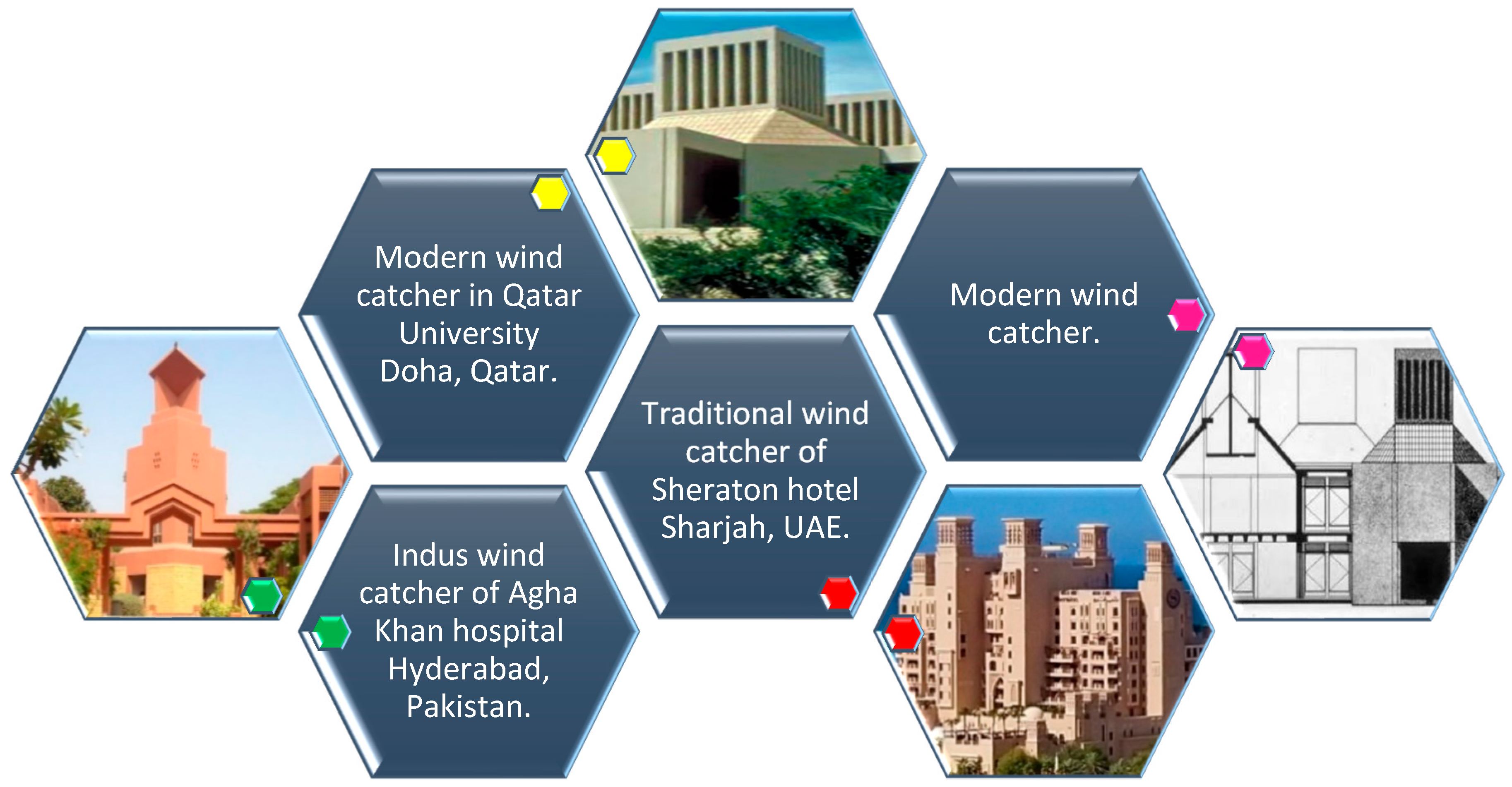

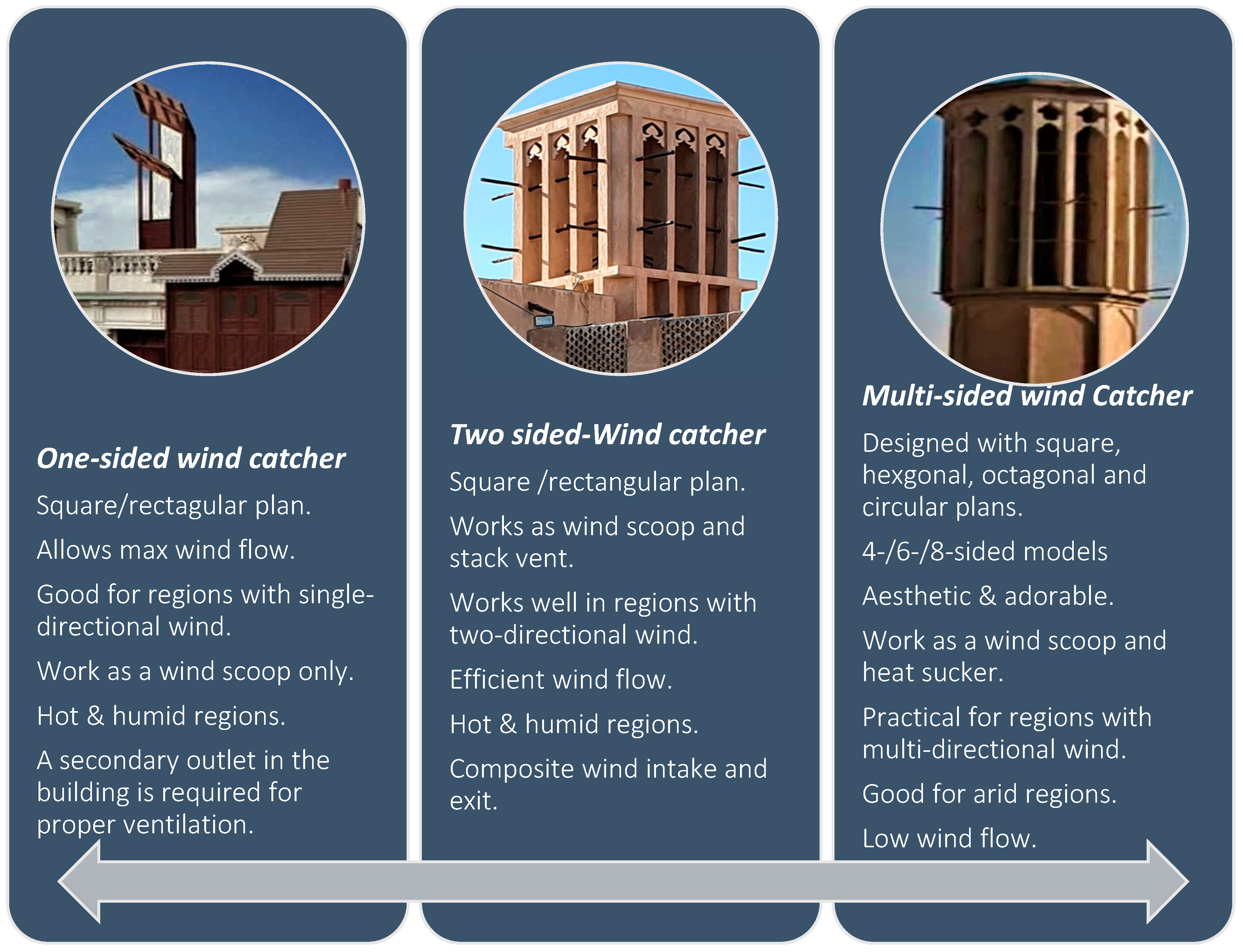



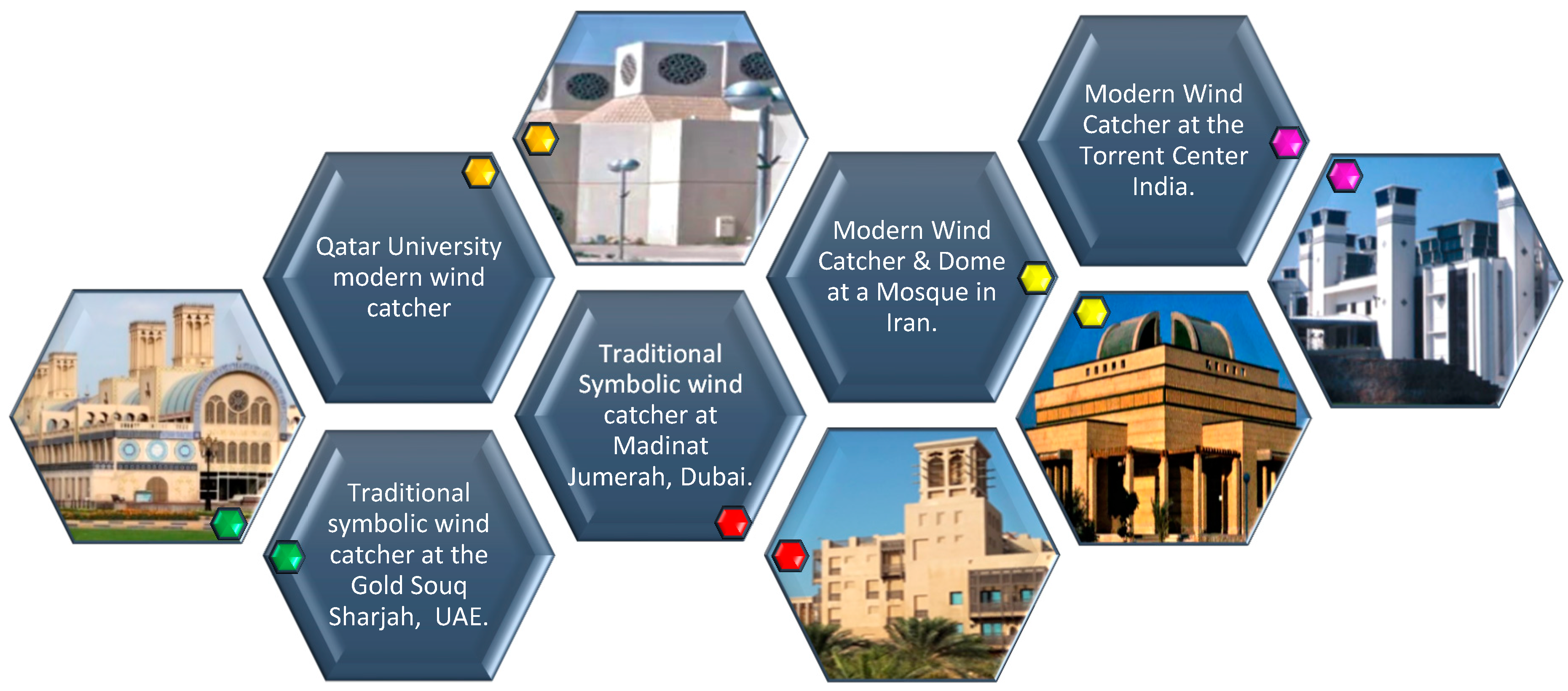

| No | References | Passive Features |
|---|---|---|
| 1 | [10] | Hybrid wind catchers with a combination of damp screens can produce a cooling effect. |
| 2 | [11] | Wind towers are a smart and sustainable method of ventilation, in regions with no or limited urban facilities. |
| 3 | [13] | Wind catchers are practical to adapt in low-height bonded building sites with minimum exterior façades. |
| 4 | [14,15] | Wind catchers also help to create a buoyancy effect in regions of low-velocity air. |
| 5 | [17] | Performance of wind catchers in low-velocity air can be improved through the integration of low-pressure PV electric fans. |
| 6 | [18] | Clean filtered air can be obtained from well-designed wind catcher, which is not possible through normal urban windows |
| 7 | [33,34,35,36] | New designs of wind catchers are evolved to best fit contemporary lifestyle and architecture. |
| Schematic Drawings | Design Criteria | Schematic Drawings | Design Criteria |
|---|---|---|---|
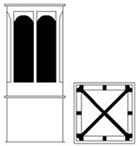 | Elevation and plan of ‘X’ blade four sided wind catcher at square plan. Commonly used in Iran & GCC countries. |  | Elevation and plan of ‘X’ blade wind catcher at hexagonal plan. Commonly used in Iran, particularly Doulat Abad and Yazd. |
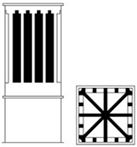 | Elevation and plan of ‘K’ blade multiple sides wind catcher at square plan. Commonly used in Iran & GCC countries. |  | Elevation (view) and plan of single side wind catcher at square plan. Indus wind catcher were used in residential buildings of historical cities of Hyderabad Sindh and Thatta. |
 | Elevation and plan of ‘H’ blade four sides wind catcher at square plan, commonly used in Iran. |  | Elevation and plan of single side multi barrel wind catcher at rectangular plan, commonly used in Iran, Egypt & Iraq. |
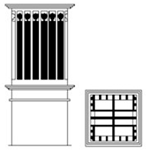 | Elevation and plan of ‘I’ blade four sided wind catcher at square plan, commonly used in Iran. |  | Elevation and plan of single side single chamber wind catcher at rectangular plan, commonly used in Iran, Egypt & Iraq. |
 | Elevation and plan of multi sides ‘X’ blade wind catcher, over circular plan and dome supported by cylindrical columns. A decorative wind catcher used in Yazd, Iran and Sharjah, UAE. |  | Elevation and plan of single side wind catcher, square plan over dome, used in fortress of Herat, Afghanistan. |
| No | Region/Country | Regional Climate | Wind Direction | Cross Section | Height of Vertical Shaft (m) | Size of Plan (m) | Ceiling of Wind Catcher | No of Sides- Wind Intake | Hybrid Function (Evaporative Cooling) |
|---|---|---|---|---|---|---|---|---|---|
| 1 | Iran | Hot & Dry | North East | Square/rectangle/hexagonal and octagonal. | 3–5 | 0.5 × 0.8, 0.7 × 1.1. | Slope of 45° | Single/Multiple | Yes |
| 2 | Iraq | Hot & Dry | North West | Rectangle | 1.8–2.10 | 0.5 × 0.15 | Slope of 45° | Single side | Yes |
| 3 | GCC countries (UAE, Bahrain, Kuwait, Qatar & Oman) | Hot & Humid | South West/North East | Square/circular | 3–5 | 1 × 1 | Flat/ Slope of 30° | Multiple | Yes |
| 4 | Pakistan | Hot & Humid/Hot & Dry | South West | Square | 2–4 | 1 × 1 | Slope of 45° | Single side | No |
| 5 | Egypt | Hot & Dry | North West | Rectangle | 3–4 | 2 × 0.5 | Slope of 30° | Single side | Yes |
| 6 | Afghanistan | Dry & Mild Hot | North | Square over circular plan | 1–1.2 | 1 × 1 | Slope of 30° | Single side | No |
| Wind Catcher Type | Modification | Issue | Design Suggestion |
|---|---|---|---|
| Single/two sided | Upper opening of shaft | Wind-borne dust | In order to avoid dusty gust into rooms, wind catcher design (single/two) can be modified by adding a dust catcher cavity in the upper opening of the shaft, along the walls of the wind catcher. |
| Square and rectangular | Cross section | Wind velocity | Square and rectangular plans (cross sections) of wind catchers are more efficient that other types of wind catchers. |
| Circular/cylindrical type | Limited height | Wind intake | Circular plan wind catchers are considered as the least efficient wind catchers because of the constraints of the incident angle and limited height. |
| All types | Wind factor | Angle of incoming wind | In general, all types of wind catchers work effectively if the angle of incoming (intake) wind is zero degrees. |
| Rectangular wind catcher | Modified intake opening through louvers | Adjustment of incoming wind angle | A rectangular wind catcher can be modified and upgraded with multiple louvers, which perform very well if incoming wind propels at a zero-degree angle. |
| All types | Height of shaft | Capture wind | Determination of wind speed in the region is important for the effectiveness of wind catcher, and in certain regions an acceptable level of wind velocity can be captured at a height of eight meters. |
| Multi opening wind catchers | No of sides | Least efficient | Provision of the maximum height of a wind catcher is more important than the number of openings in a wind catcher. |
| Single or two side wind catcher | Smart sensors and PV powered hoppers at wind intake opening | Block hot outer wind | Smart temperature sensors and electro-mechanical shutters or hoppers can be fixed at the lower opening of a wind catcher shaft to prevent the intake of outside air with higher temperature. |
| All types of wind catcher | Size of intake opening | Effective wind intake | The size of a wind catcher opening should be in an acceptable ratio to floors, i.e., the opening of wind catcher should be 8–12% of the floor area |
| All Types | Temp requirement for better performance | General requirement | Wind catchers are highly efficient in regions that have substantial variation in day and night temperature, for example, in day time the mercury reaches 35–40 degree centigrade, and in the evening (sunset) temperature drops to 25–30 degrees centigrade. |
| All types | Temp requirement for better performance | General requirement | Wind catchers can work effectively if the maximum variation between the indoor and outdoor temperature is 10–15 °C. |
| One and two sides | Modification of shaft lower opening | Prevention of rain penetration | In certain regions, monsoon rains in summer disturb the function of wind catchers and causes soaking through the shaft. This can minimized by the collection of soak-away water through making a drip at edges of the lower opening of the shaft or adding a ‘U’ channel to collect water. |
| One and two sides | PV powered, low-velocity vapor fan system at wind intake opening | Low velocity hot air | In arid regions with low air velocity, a wind catcher can be modified with a PV (photovoltaic) low-speed fan and vapor system (mist) at the lower end of the shaft to enhance wind temperature and draft inside the building. |
Publisher’s Note: MDPI stays neutral with regard to jurisdictional claims in published maps and institutional affiliations. |
© 2022 by the authors. Licensee MDPI, Basel, Switzerland. This article is an open access article distributed under the terms and conditions of the Creative Commons Attribution (CC BY) license (https://creativecommons.org/licenses/by/4.0/).
Share and Cite
Chohan, A.H.; Awad, J. Wind Catchers: An Element of Passive Ventilation in Hot, Arid and Humid Regions, a Comparative Analysis of Their Design and Function. Sustainability 2022, 14, 11088. https://doi.org/10.3390/su141711088
Chohan AH, Awad J. Wind Catchers: An Element of Passive Ventilation in Hot, Arid and Humid Regions, a Comparative Analysis of Their Design and Function. Sustainability. 2022; 14(17):11088. https://doi.org/10.3390/su141711088
Chicago/Turabian StyleChohan, Afaq Hyder, and Jihad Awad. 2022. "Wind Catchers: An Element of Passive Ventilation in Hot, Arid and Humid Regions, a Comparative Analysis of Their Design and Function" Sustainability 14, no. 17: 11088. https://doi.org/10.3390/su141711088
APA StyleChohan, A. H., & Awad, J. (2022). Wind Catchers: An Element of Passive Ventilation in Hot, Arid and Humid Regions, a Comparative Analysis of Their Design and Function. Sustainability, 14(17), 11088. https://doi.org/10.3390/su141711088






